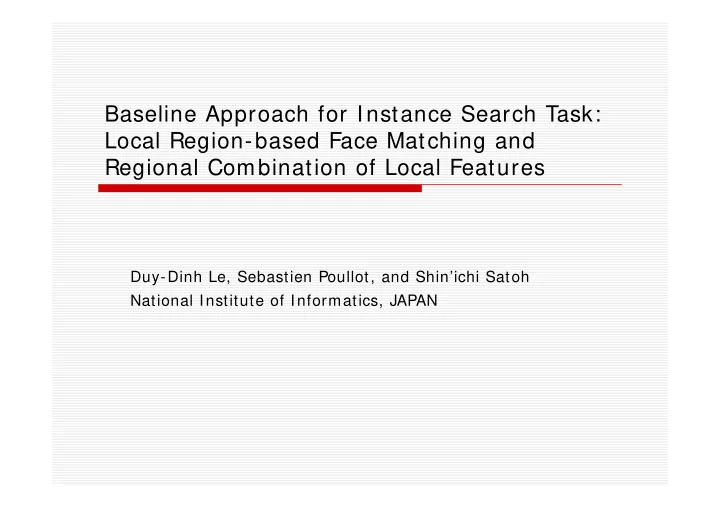

Baseline Approach for Instance Search Task: Local Region-based Face Matching and Regional Combination of Local Features Duy-Dinh Le, Sebastien Poullot, and Shin’ichi Satoh National Institute of Informatics, JAPAN
Task Overview “Given a collection of queries that delimit a person, object, or place entity in some example video, locate for each query the 1000 shots most likely to contain a recognizable instance of the entity.” (cf. TRECVID guideline) . Examples for one query ~ 5 frame images. mask of an inner region of interest. the inner region against a grey background. the frame image with the inner region region outlined in red. a list of vertices for the inner region region the target type: PERSON, CHARACTER, LOCATION, OBJECT.
Challenges – PERSON (1/ 2) Large variations in poses, sizes, facial expressions, illuminations, aging, complex background, etc. Examples George H. W. Bush vs George W. Bush.
Challenges – OBJECT (2/ 2) Large variations in orientations, sizes, deformations, etc. Examples
Baseline Approach – Overview (1/ 2) System 1: Different treatments for different query types: PERSON, CHARACTER vs OBJECT, LOCATION. Face representation: local region-based feature. Frame representation: SIN task features global + local features.
Baseline Approach – Overview (2/ 2) System 2: General treatment for all queries. Focus on the mask of query examples. Region representation: CCD task features: regional combination of local features.
Feature Representation – System 1 (1/ 2) Face feature Frontal faces are detected by NII’s face detector (similar to Viola-Jones face detector). Pixel intensity inside 15x15 circular regions corresponding to 13 facial points (9 facial feature points are detected, 4 more facial feature points (1) are inferred from these 9 points) → 13x149 = 1,937 dimensions. (using code provided by VGG – Oxford, UK) (2) . Local binary patterns feature extracted from 5x5 grid, 30 bins → 5x5x30 = 750 dimensions. (1) the centers of the eyes, a point between the eyes, and the center of the mouth. (2) http: / / www.robots.ox.ac.uk/ ~ vgg/ research/ nface/
Feature Representation – System 1 (2/ 2) Global feature – SIN task Color moments: 5x5 grid, HSV space → 5x5x3x3 = 225 dimensions. Local binary patterns: 5x5 grid, 30 bins → 5x5x30 = 750 dimensions. Local feature 10 predefined regions. BoW of SIFT descriptors extracted from keypoints detected by HARHES keypoint detector. 738 words x 10 regions = 7,380 dims.
Retrieval Strategy – System 1 For PERSON queries, extract frontal faces and face descriptors. Extract frame descriptors for all query examples and keyframes in the reference database (50 keyframes/ shot). Compute similarity between query examples and keyframes using the face descriptors and the frame descriptors. The similarities are L1, L2 for the face descriptors and the global features. HIK for the local feature. No indexing technique is used to boost the speed. Compute the similarity score for one query and one shot Pick the minimum score among pairs between query examples and the keyframes of the input shot. Fusion the scores of face descriptors and frame descriptors Normalize scores using sigmoid function. Linear combination of weighted scores Very high weight for the face descriptor: w face = 300. Focus on FACE. Low weight for the frame descriptors: w frame_i = 1.
Feature Representation – System 2 Query Focus on mask of query examples. Extract Sift(DoG) features and synthesis Glocal features on a 2048 words vocabulary. Take normalized RGB histogram of the area. → 2 descriptors for each query example. Reference database Extract low rate KF (0.4 per second). Extract Sift(DoG) features and synthesis Glocal features on a 2048 words vocabulary. Take normalized RGB histogram of the area. → 2 descriptors for each keyframe.
Retrieval Strategy – System 2 Compute similarity between query example descriptors and keyframe ones. The similarities are Dice coefficient for Glocal. L1 for RGB histograms. Simply added together for 1 query example. All similarity scores of the query examples are added for each keyframe.
Results (* ) – System 1 (1/ 2) L1 is the most suitable choice for similarity measure. Good face feature brings good result. (* ) http: / / satoh-lab.ex.nii.ac.jp/ users/ ledduy/ nii-trecvid/ ins-tv10/ ins-tv10.php → view query examples, groundtruth, and ranked lists.
Results – System 1 (2/ 2) Performance for PERSON(8) and CHARACTER(5) queries → 13 queries. Good performance for PERSON/ CHARACTER queries Performance for OBJECT(8) and LOCATION(1) queries → 9 queries. Poor performance for OBJECT/ LOCATION queries
Some Results – System 1 System-1: Fusion helps to improve the performance Only face descriptor: 8 - 15 - 18 - 20 Fusion: 7 - 11 - 17 - 19
Some Results – System 1 Color m om ents feature good performance for PERSON queries Rank 1, and 10
Some Results – System 1 Local feature HI K m ight not be suitable similarity measure since it is easy to bias in favor of images with complex texture.
Some Results – System 2
Some Results – System 2
Some Results – System 2
Discussions For PERSON and CHARACTER queries, the (max) performance is usually high. Current face matching technique only handles frontal faces. More efforts should be made to handle multi-view faces.
Discussions - 1 Fusion of different features for different object types helps to improve the performance. However, how to efficiently fuse is questionable. Our approach is quite ad-hoc. Appropriate similarity measure should be carefully selected. Dense sampling in keyframe extraction is an important factor. No face detected in query examples Dense sampling helps to find the relevant ones
Discussions - 2 Bad quality of queries is damageable for local feature. Color moments feature is simple, but can achieve reasonable result. In some cases, it outperforms local features. How to deal with scale and comparison to images from reference database.
Demo – 1 URL: http: / / satoh-lab.ex.nii.ac.jp/ users/ ledduy/ nii-trecvid/ ins-tv10/ ins-tv10.php Username/ password: trecvid/ niitrec. Functions: view query examples, ground truth, and ranked lists of runs.
Relevant I rrelevant Demo - 2 Result page
Thank you and Question
Recommend
More recommend